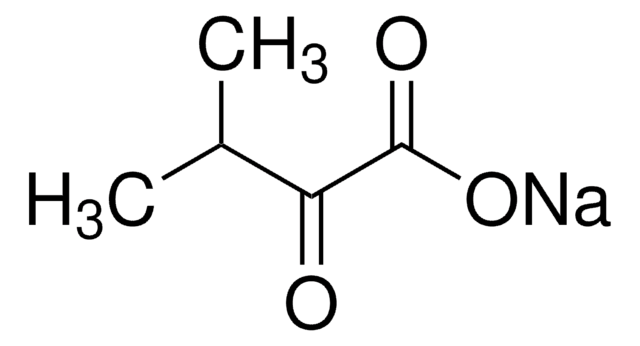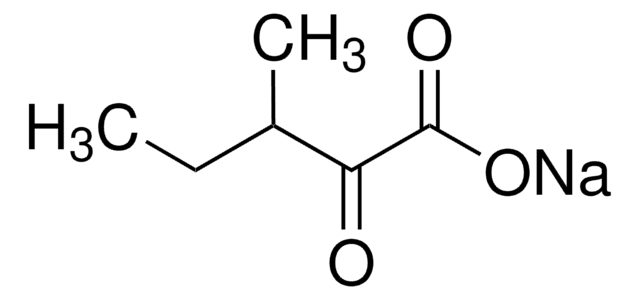Key Documents
K0629
Sodium 4-methyl-2-oxovalerate
leucine metabolite
Synonim(y):
α-Ketoisocaproic acid sodium salt, 4-Methyl-2-oxopentanoic acid sodium salt, 4-Methyl-2-oxovaleric acid sodium salt, Ketoleucine sodium salt
About This Item
Polecane produkty
Poziom jakości
Próba
>98% (TLC)
Postać
powder
metody
HPLC: suitable
kolor
white to off-white
mp
275 °C (dec.) (lit.)
Zastosowanie
cell analysis
temp. przechowywania
2-8°C
ciąg SMILES
[Na+].CC(C)CC(=O)C([O-])=O
InChI
1S/C6H10O3.Na/c1-4(2)3-5(7)6(8)9;/h4H,3H2,1-2H3,(H,8,9);/q;+1/p-1
Klucz InChI
IXFAZKRLPPMQEO-UHFFFAOYSA-M
Szukasz podobnych produktów? Odwiedź Przewodnik dotyczący porównywania produktów
Powiązane kategorie
Zastosowanie
Działania biochem./fizjol.
Hasło ostrzegawcze
Warning
Zwroty wskazujące rodzaj zagrożenia
Zwroty wskazujące środki ostrożności
Klasyfikacja zagrożeń
Eye Irrit. 2
Kod klasy składowania
11 - Combustible Solids
Klasa zagrożenia wodnego (WGK)
WGK 3
Temperatura zapłonu (°F)
Not applicable
Temperatura zapłonu (°C)
Not applicable
Środki ochrony indywidualnej
Eyeshields, Gloves, type N95 (US)
Certyfikaty analizy (CoA)
Poszukaj Certyfikaty analizy (CoA), wpisując numer partii/serii produktów. Numery serii i partii można znaleźć na etykiecie produktu po słowach „seria” lub „partia”.
Masz już ten produkt?
Dokumenty związane z niedawno zakupionymi produktami zostały zamieszczone w Bibliotece dokumentów.
Klienci oglądali również te produkty
Nasz zespół naukowców ma doświadczenie we wszystkich obszarach badań, w tym w naukach przyrodniczych, materiałoznawstwie, syntezie chemicznej, chromatografii, analityce i wielu innych dziedzinach.
Skontaktuj się z zespołem ds. pomocy technicznej









